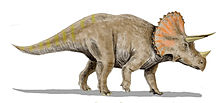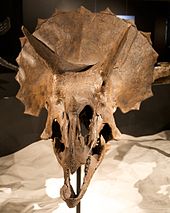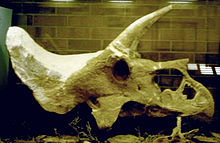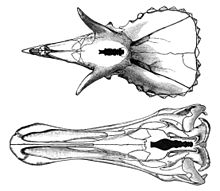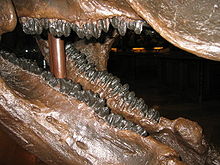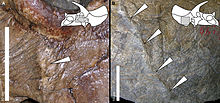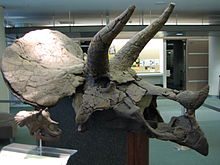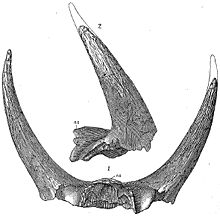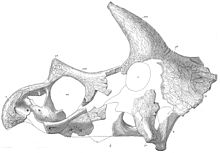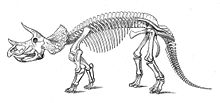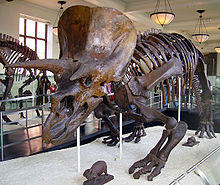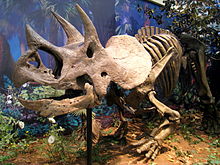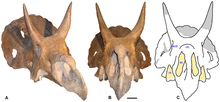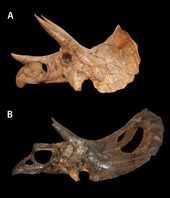
Triceratops
Did you know...
This Wikipedia selection is available offline from SOS Children for distribution in the developing world. A good way to help other children is by sponsoring a child
| Triceratops Temporal range: Late Cretaceous, 68–65.5Ma |
|
|---|---|
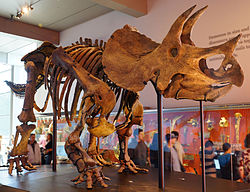 |
|
| T. horridus skeleton mounted with modern limb-posture, Natural History Museum of Los Angeles County | |
| Scientific classification |
|
| Kingdom: | Animalia |
| Phylum: | Chordata |
| Class: | Reptilia |
| Order: | †Ornithischia |
| Suborder: | †Ceratopsia |
| Family: | †Ceratopsidae |
| Tribe: | †Triceratopsini |
| Genus: | †Triceratops Marsh, 1889 |
| Type species | |
| †Triceratops horridus Marsh, 1889 |
|
| Species | |
|
†T. horridus Marsh, 1889 |
|
| Synonyms | |
|
Agathaumas? Cope, 1872 |
|
Triceratops (pron.: / t r aɪ ˈ s ɛr ə t ɒ p s / try-SERR-ə-tops) is a genus of herbivorous ceratopsid dinosaur that lived during the late Maastrichtian stage of the Late Cretaceous Period, around 68 to 65.5 million years ago (Mya) in what is now North America. It was one of the last non-avian dinosaur genera to appear before the Cretaceous–Paleogene extinction event. The term Triceratops, which literally means "three-horned face", is derived from the Greek τρί- (tri-) meaning "three", κέρας (kéras) meaning "horn", and ὤψ (ops) meaning "face".
Bearing a large bony frill and three horns on its large four-legged body, and conjuring similarities with the modern rhinoceros, Triceratops is one of the most recognizable of all dinosaurs and the best known ceratopsid. It shared the landscape with and was preyed upon by the fearsome Tyrannosaurus, though it is less certain that the two did battle in the manner often depicted in traditional museum displays and popular images.
The exact placement of the Triceratops genus within the ceratopsid group has been debated by paleontologists. Two species, T. horridus and T. prorsus, are considered valid although many other species have been named. Recent research suggests that the contemporaneous Torosaurus, a ceratopsid long regarded as a separate genus, represents Triceratops in its mature form, though this is disputed.
Triceratops has been documented by numerous remains collected since the genus was first described in 1889, including at least one complete individual skeleton. Paleontologist John Scannella observed: "It is hard to walk out into the Hell Creek Formation and not stumble upon a Triceratops weathering out of a hillside." Forty-seven complete or partial skulls were discovered in just that area during the decade 2000–2010. Specimens representing life stages from hatchling to adult have been found.
The function of the frills and three distinctive facial horns has long inspired debate. Traditionally these have been viewed as defensive weapons against predators. More recent theories, noting the presence of blood vessels in the skull bones of ceratopsids, find it more probable that these features were primarily used in identification, courtship and dominance displays, much like the antlers and horns of modern reindeer, mountain goats, or rhinoceros beetles. The theory finds additional support if Torosaurus represents the mature form of Triceratops, as this would mean the frill also developed holes ( fenestrae) as individuals reached maturity, rendering the structure more useful for display than defense.
Description
Individual Triceratops are estimated to have reached about 7.9 to 9.0 m (26.0–29.5 ft) in length, 2.9 to 3.0 m (9.5–9.8 ft) in height, and 6.1–12.0 tonnes (13,000–26,000 lb) in weight. The most distinctive feature is their large skull, among the largest of all land animals. The largest known skull (specimen BYU 12183) is estimated to have been 2.5 metres (8.2 ft) in length when complete, and could reach almost a third of the length of the entire animal. It bore a single horn on the snout, above the nostrils, and a pair of horns approximately 1 m (3 ft) long, with one above each eye. To the rear of the skull was a relatively short, bony frill, adorned with epoccipitals in some specimens. Most other ceratopsids had large fenestrae in their frills, while those of Triceratops were noticeably solid.
The skin of Triceratops was unusual compared to other dinosaurs. Skin impressions from an as-yet undescribed specimen show that some species may have been covered in bristle-like structures, similar to the more primitive ceratopsian Psittacosaurus.
Limbs
Triceratops species possessed a sturdy build, with strong limbs and short three-hoofed hands and four-hoofed feet. Although certainly quadrupedal, the posture of these dinosaurs has long been the subject of some debate. Originally, it was believed that the front legs of the animal had to be sprawling at angles from the thorax, in order to better bear the weight of the head. This stance can be seen in paintings by Charles Knight and Rudolph Zallinger. Ichnological evidence in the form of trackways from horned dinosaurs, and recent reconstructions of skeletons (both physical and digital) seem to show that Triceratops and other ceratopsids maintained an upright stance during normal locomotion, with the elbows flexed and slightly bowed out, in an intermediate state between fully upright and fully sprawling (as in the modern rhinoceros).
The hands and forearms of Triceratops retained a fairly primitive structure compared to other quadrupedal dinosaurs such as thyreophorans and many sauropods. In those two groups, the forelimbs of quadrupedal species were usually rotated so that the hands faced forward with palms backward ("pronated") as the animals walked. Triceratops, like other ceratopsians and the related quadrupedal ornithopods, walked with most of their fingers pointing out and away from the body, the primitive condition for dinosaurs also retained by bipedal forms like the theropods. In Triceratops, the weight of the body was carried by only the first three fingers of the hand, while the third and fourth were vestigial and lacked claws or hooves.
Classification
Triceratops is the best known genus of the Ceratopsidae, a family of large North American horned dinosaurs. The exact location of Triceratops among the ceratopsians has been debated over the years. Confusion stemmed mainly from the combination of short, solid frills (similar to that of Centrosaurinae), and the long brow horns (more akin to Ceratopsinae, also known as Chasmosaurinae). In the first overview of horned dinosaurs, R. S. Lull hypothesized two lineages, one of Monoclonius and Centrosaurus leading to Triceratops, the other with Ceratops and Torosaurus, making Triceratops a centrosaurine as the group is understood today. Later revisions supported this view, formally describing the first, short-frilled group as Centrosaurinae (including Triceratops), and the second, long-frilled group as Chasmosaurinae.
In 1949, C. M. Sternberg was the first to question this and favoured instead that Triceratops was more closely related to Arrhinoceratops and Chasmosaurus based on skull and horn features, making Triceratops a ceratopsine (chasmosaurine of his usage) genus. He was largely ignored, with John Ostrom, and later David Norman both placing Triceratops within Centrosaurinae.
Subsequent discoveries and analyses upheld Sternberg's view on the position of Triceratops, with Lehman defining both subfamilies in 1990 and diagnosing Triceratops as ceratopsine (chasmosaurine of his usage) on the basis of several morphological features. In fact, it fits well into the ceratopsine subfamily, apart from its one feature of a shortened frill. Further research by Peter Dodson, including a 1990 cladistic analysis and a 1993 study using RFTRA (resistant-fit theta-rho analysis), a morphometric technique which systematically measures similarities in skull shape, reinforces Triceratops' placement in the ceratopsine subfamily.
This classification found additional support in 2010 from John Scannella and Jack Horner at the Museum of the Rockies (Bozeman, Montana). After examining 38 skulls from the Hell Creek formation, Scanella and Horner concluded that the mature form of Triceratops did not even have a shortened frill. The specimens long classified as Triceratops, they argued, represented juvenile and young adult individuals while mature individuals had been incorrectly assigned to a separate genus, Torosaurus. It was already known that the frills of Triceratops grew progressively longer as individuals matured; Scanella and Horner said their findings showed that this growth could culminate in the extended, fenestrated frill associated with Torosaurus. With the name Triceratops taking historical priority, they announced that references to the genus Torosaurus would be eliminated from Museum of the Rockies exhibits.
Use in phylogenetics
In phylogenetic taxonomy, the genus has been used as a reference point in the definition of Dinosauria; Dinosaurs have been designated as all descendants of the most recent common ancestor of Triceratops and Neornithes (i.e. modern birds). Furthermore, the bird-hipped dinosaurs, Ornithischia, have been designated as all dinosaurs with a more recent common ancestor to Triceratops than modern birds.
Evolutionary origins
For many years after its discovery the evolutionary origins of Triceratops remained largely obscure. In 1922 the newly discovered Protoceratops was seen as its ancestor by Henry Fairfield Osborn, but many decades passed before additional findings came to light. Recent years have been fruitful for the discovery of several dinosaurs related to ancestors of Triceratops. Zuniceratops, the earliest known ceratopsian with brow horns, was described in the late 1990s, and Yinlong, the first known Jurassic ceratopsian, in 2005.
These new finds have been vital in illustrating the origins of horned dinosaurs in general, suggesting an Asian origin in the Jurassic, and the appearance of truly horned ceratopsians by the beginning of the late Cretaceous in North America. As Triceratops is increasingly shown to be a member of the long-frilled Ceratopsinae subfamily, a likely ancestor may have resembled Chasmosaurus, which thrived some 5 million years earlier.
Paleobiology
Although Triceratops are commonly portrayed as herding animals, there is currently little evidence that they lived in herds. While several other genera of horned dinosaurs are known from bonebeds preserving bones from two to hundreds or thousands of individuals, to date there is only one documented bonebed dominated by Triceratops bones: a site in southeastern Montana with the remains of three juveniles. It may be significant that only juveniles were present.
For many years, Triceratops finds were known only from solitary individuals. These remains are very common; for example, Bruce Erickson, a paleontologist of the Science Museum of Minnesota, has reported having seen 200 specimens of T. prorsus in the Hell Creek Formation of Montana. Similarly, Barnum Brown claimed to have seen over 500 skulls in the field. Because Triceratops teeth, horn fragments, frill fragments, and other skull fragments are such abundant fossils in the Lancian faunal stage of the late Maastrichtian ( late Cretaceous, 68 to 65 mya) Period of western North America, it is regarded as among the dominant herbivores of the time, if not the most dominant herbivore. In 1986, Robert Bakker estimated it as making up 5/6ths of the large dinosaur fauna at the end of the Cretaceous. Unlike most animals, skull fossils are far more common than postcranial bones for Triceratops, suggesting that the skull had an unusually high preservation potential.
Triceratops was one of the last ceratopsian genera to appear before the Cretaceous–Paleogene extinction event. The related Torosaurus, and the more distantly related diminutive Leptoceratops, were also present, though their remains have been rarely encountered.
Dentition and diet
Triceratops were herbivorous, and because of their low head, their primary food was probably low growth, although they may have been able to knock down taller plants with their horns, beak, and bulk. The jaws were tipped with a deep, narrow beak, believed to have been better at grasping and plucking than biting.
Triceratops teeth were arranged in groups called batteries, of 36 to 40 tooth columns, in each side of each jaw with 3 to 5 stacked teeth per column, depending on the size of the animal. This gives a range of 432 to 800 teeth, of which only a fraction were in use at any given time (tooth replacement was continuous and occurred throughout the life of the animal). They functioned by shearing in a vertical to near-vertical orientation. The great size and numerous teeth of Triceratops suggests that they ate large volumes of fibrous plant material, with some suggesting palms and cycads, and others suggesting ferns, which then grew in prairies.
Functions of the horns and frill
There has been much speculation over the functions of Triceratops' head adornments. The two main theories have revolved around use in combat, or display in courtship, with the latter thought now to be the most likely primary function.
Early on, Lull postulated that the frills may have served as anchor points for the jaw muscles to aid chewing by allowing increased size and thus power for the muscles. This has been put forward by other authors over the years, but later studies do not find evidence of large muscle attachments on the frill bones.
Triceratops were long thought to have possibly used their horns and frills in combat with predators such as Tyrannosaurus, the idea being discussed first by C. H. Sternberg in 1917 and 70 years later by Robert Bakker. There is evidence that Tyrannosaurus did have aggressive head-on encounters with Triceratops, based on partially healed tyrannosaur tooth marks on a Triceratops brow horn and squamosal; the bitten horn is also broken, with new bone growth after the break. Which animal was the aggressor is not known. Since the Triceratops wounds healed, it is most likely that the Triceratops survived the encounter and managed to overcome the Tyrannosaurus. Paleontologist Peter Dodson estimates that if Tyrannosaurus attacked a bull Triceratops, the Triceratops had the upper hand and would successfully defend itself by inflicting fatal wounds to the Tyrannosaurus using its sharp horns. Tyrannosaurus is also known to have fed on Triceratops. Evidence for this includes a heavily tooth-scored Triceratops ilium and sacrum.
In addition to combat with predators using horns, Triceratops are classically shown engaging each other in combat with horns locked. While studies show that such activity would be feasible, if unlike that of present-day horned animals, there is disagreement about whether they did so. Although pitting, holes, lesions, and other damage on Triceratops skulls (and the skulls of other ceratopsids) are often attributed to horn damage in combat, a recent study finds no evidence for horn thrust injuries causing these forms of damage (for example, there is no evidence of infection or healing). Instead, non-pathological bone resorption, or unknown bone diseases, are suggested as causes. A newer study compared incidence rates of skull lesions and periosteal reaction in Triceratops and Centrosaurus and showed that these were consistent with Triceratops using its horns in combat and the frill being adapted as a protective structure, while lower pathology rates in Centrosaurus may indicate visual rather than physical use of cranial ornamentation, or a form of combat focused on the body rather than the head. The researchers also concluded that the damage found on the specimens in the study was often too localized to be caused by bone disease.
The large frill also may have helped to increase body area to regulate body temperature. A similar theory has been proposed regarding the plates of Stegosaurus, although this use alone would not account for the bizarre and extravagant variation seen in different members of the Ceratopsidae. This observation is highly suggestive of what is now believed to be the primary function, display.
The theory of their use in sexual display was first proposed by Davitashvili in 1961 and has gained increasing acceptance since. Evidence that visual display was important, either in courtship or in other social behavior, can be seen in the fact that horned dinosaurs differ markedly in their adornments, making each species highly distinctive. Also, modern living creatures with such displays of horns and adornments use them in similar behaviour. A recent study of the smallest Triceratops skull, ascertained to be a juvenile, shows the frill and horns developed at a very early age, predating sexual development and thus probably important for visual communication and species recognition in general.
Discovery and identification
The first named specimen now attributed to Triceratops is a pair of brow horns attached to a skull roof, found near Denver, Colorado in the spring of 1887. This specimen was sent to Othniel Charles Marsh, who believed that the formation from which it came dated from the Pliocene, and that the bones belonged to a particularly large and unusual bison, which he named Bison alticornis. He realized that there were horned dinosaurs by the next year, which saw his publication of the genus Ceratops from fragmentary remains, but he still believed B. alticornis to be a Pliocene mammal. It took a third and much more complete skull to change his mind. The specimen, collected in 1888 by John Bell Hatcher from the Lance Formation of Wyoming, was initially described as another species of Ceratops. After reflection, Marsh changed his mind and gave it the generic name Triceratops, accepting his Bison alticornis as another species of Ceratops (it would later be added to Triceratops). The sturdy nature of the animal's skull has ensured that many examples have been preserved as fossils, allowing variations between species and individuals to be studied. Triceratops remains have subsequently been found in the American states of Montana and South Dakota (in addition to Colorado and Wyoming), and in the Canadian provinces of Saskatchewan and Alberta.
An earlier specimen, also recovered from the Lance Formation, was named Agathaumas sylvestris by Edward Drinker Cope in 1872. Originally identified as a hadrosaur, this specimen consists only of post-cranial remains and is only provisionally considered an example of Triceratops.
Species
Within the first decades after Triceratops was described, various skulls were collected, which varied to a lesser or greater degree from the original Triceratops, named T. horridus by Marsh (from the Latin horridus; "rough, rugose", suggesting the roughened texture of those bones belonging to the type specimen, later identified as an aged individual). This variation is unsurprising, given that Triceratops skulls are large three-dimensional objects, coming from individuals of different ages and both sexes, and which were subjected to different amounts and directions of pressure during fossilization. Discoverers would name these as separate species (listed below), and came up with several phylogenetic schemes for how they were related to each other.
In the first attempt to understand the many species, Lull found two groups, although he did not say how he distinguished them: one composed of T. horridus, T. prorsus, and T. brevicornus; the other of T. elatus and T. calicornis. Two species (T. serratus and T. flabellatus) stood apart from these groups. By 1933, and his revision of the landmark 1907 Hatcher-Marsh-Lull monograph of all known ceratopsians, he retained his two groups and two unaffiliated species, with a third lineage of T. obtusus and T. hatcheri that was characterized by a very small nasal horn. T. horridus-T. prorsus-T. brevicornus was now thought to be the most conservative lineage, with an increase in skull size and a decrease in nasal horn size, and T.-elatus-T. calicornis was defined by large brow horns and small nasal horn. C. M. Sternberg made one modification, adding T. eurycephalus and suggesting that it linked the second and third lineages closer together than they were to the T. horridus lineage. This pattern was followed until the major studies of the 1980s and 1990s.
With time, the idea that the differing skulls might be representative of individual variation within one (or two) species gained popularity. In 1986, Ostrom and Wellnhofer published a paper in which they proposed that there was only one species, Triceratops horridus. Part of their rationale was that generally there are only one or two species of any large animal in a region (modern examples being the elephant and the giraffe in modern Africa). To their findings, Lehman added the old Lull-Sternberg lineages combined with maturity and sexual dimorphism, suggesting that the T. horridus-T. prorsus-T. brevicornus lineage was composed of females, the T.calicornis-T.elatus lineage was made up of males, and the T. obtusus-T. hatcheri lineage was of pathologic old males. His reasoning was that males had taller, more erect horns and larger skulls, and females had smaller skulls with shorter, forward-facing horns.
These findings were contested a few years later by Catherine Forster, who reanalyzed Triceratops material more comprehensively and concluded that the remains fell into two species, T. horridus and T. prorsus, although the distinctive skull of T. ("Nedoceratops") hatcheri differed enough to warrant a separate genus. She found that T. horridus and several other species belonged together, and T. prorsus and T. brevicornus stood alone, and since there were many more specimens in the first group, she suggested that this meant the two groups were two species. It is still possible to interpret the differences as representing a single species with sexual dimorphism.
In 2009, John Scannella and Denver Fowler supported the separation of T. prorsus and T. horridus, and noted that the two species are also separated stratigraphically within the Hell Creek Formation, indicating that they did not live together at the same time.
Valid species
- T. horridus (Marsh, 1889) (originally Ceratops) ( type species)
- T. prorsus (Marsh, 1890)
Synonyms and doubtful species
The following species are considered nomina dubia ("dubious names"), and are based on remains that are too poor or incomplete to be distinguished from pre-existing Triceratops species.
- T. albertensis ( C. M. Sternberg, 1949)
- T. alticornis ( Marsh, 1887 [originally Bison])
- T. brevicornus (Hatcher, 1905) (=T. prorsus)
- T. calicornis (Marsh, 1898) (=T. horridus)
- T. elatus (Marsh, 1891) (=T. horridus)
- T. eurycephalus ( Schlaikjer, 1935)
- T. flabellatus (Marsh, 1889) (=T. horridus)
- T. galeus (Marsh, 1889)
- T. hatcheri (Lull, 1907) (contentious; see Nedoceratops below)
- T. ingens ( Lull, 1915)
- T. maximus ( Brown, 1933)
- T. mortuarius ( Cope, 1874) (nomen dubium; originally Polyonax mortuarius)
- T. obtusus (Marsh, 1898) (=T. horridus)
- T. serratus (Marsh, 1890) (=T. horridus)
- T. sulcatus (Marsh, 1890)
- T. sylvestris (Cope, 1872) (nomen dubium; originally Agathaumas sylvestris)
Nedoceratops
The paper that described Nedoceratops was originally part of O. C. Marsh's magnum opus, his Ceratopsidae monograph. Unfortunately, Marsh died (1899) before the work was completed, and John Bell Hatcher endeavored to complete the Triceratops section. He died of typhus in 1904 at the age of 42, leaving the paper still uncompleted. It fell to Richard Swann Lull to complete the monograph in 1905, publishing Hatcher's description of a skull separately and giving it the name Diceratops hatcheri; Diceratops means "two horned face."
Since the Diceratops paper had been written by Hatcher, and Lull had only contributed the name and published the paper after Hatcher's death, Lull was not quite as convinced of the distinctiveness of Diceratops, thinking it primarily pathological. By 1933, Lull had had second thoughts about Diceratops being a distinct genus and he put it in a subgenus of Triceratops: Triceratops (Diceratops), including T. obtusus; largely attributing its differences to being that of an aged individual.
Because the name Diceratops was already in use for a hymenopteran (Foerster, 1868), Andrey Sergeyevich Ukrainsky gave the animal its current name Nedoceratops in 2007. Unaware that Ukrainsky had already renamed the animal, Octávio Mateus coined another new name for it in 2008, Diceratus. Diceratus is thus a junior synonym of Nedoceratops.
Opinion has varied on the validity of a separate genus for hatcheri. John Scannella and Jack Horner regarded it as an intermediate growth stage between Triceratops and Torosaurus. Andrew Farke, in his 2011 redescription of the only known skull, concluded that it was an aged individual of its own valid taxon, Nedoceratops hatcheri.
Torosaurus
Torosaurus is a ceratopsid genus first identified from a pair of skulls in 1891, two years after the identification of Triceratops. The Torosaurus genus resembles Triceratops in geological age, distribution, anatomy and physical size and it has been recognised as a close relative. Its distinguishing features are an elongated skull and the presence of two fenestrae, or holes, in the frill. Paleontologists investigating dinosaur ontogeny (growth and development of individuals over the life span) in the Hell Creek Formation of Montana, have recently presented evidence that the two represent a single genus.
John Scannella, in a paper presented in Bristol, UK at the conference of the Society of Vertebrate Paleontology (2009 September 25) reclassified Torosaurus as especially mature Triceratops individuals, perhaps representing a single sex. Jack Horner, Scannella's mentor at Montana State University, noted that ceratopsian skulls consist of metaplastic bone. A characteristic of metaplastic bone is that it lengthens and shortens over time, extending and resorbing to form new shapes. Significant variety is seen even in those skulls already identified as Triceratops, Horner said, "where the horn orientation is backwards in juveniles and forward in adults". Approximately 50% of all subadult Triceratops skulls have two thin areas in the frill that correspond with the placement of "holes" in Torosaurus skulls, suggesting that holes developed to offset the weight that would otherwise have been added as maturing Triceratops individuals grew longer frills. A paper describing these findings in detail was published in July 2010 by Scannella and Horner. In it, they formally argued that Torosaurus, as well as the similar contemporary Nedoceratops, were synonymous with Triceratops. Farke (2011) disagreed with their conclusions. He found Nedoceratops to be distinct and the proposed changes required to "age" a Triceratops into a Torosaurus without precedent among ceratopsids, requiring addition of epoccipitals, reversion of bone texture from adult to immature back to adult, and late growth of holes in the frill.
Ojoceratops and Tatankaceratops
In one subsequent paper, paleontologist Nick Longrich argued that the synonymy of Triceratops and Torosaurus could not be supported without better intermediate forms than Scannella and Horner initially provided. Longrich agreed that Nedoceratops is a synonym of Triceratops, and suggested that the recently described Ojoceratops was indistinguishable from T. horridus specimens previously attributed to the defunct species T. serratus. Longrich suggested that another new genus at the time, Tatankaceratops, possessed a strange mix of characteristics from adult and juvenile Triceratops specimens. Longrich noted that this could represent a dwarf Triceratops species or simply a Triceratops specimen with a developmental disorder which caused it to stop growing prematurely.

